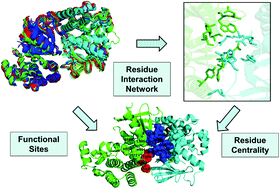Molecular dynamics simulations and modelling of the residue interaction networks in the BRAF kinase complexes with small molecule inhibitors: probing the allosteric effects of ligand-induced kinase dimerization and paradoxical activation
Abstract
Protein kinases are central to proper functioning of cellular networks and are an integral part of many signal transduction pathways. The family of protein kinases represents by far the largest and most important class of therapeutic targets in oncology. Dimerization-induced activation has emerged as a common mechanism of allosteric regulation in BRAF kinases, which play an important role in growth factor signalling and human diseases. Recent studies have revealed that most of the BRAF inhibitors can induce dimerization and paradoxically stimulate enzyme transactivation by conferring an active conformation in the second monomer of the kinase dimer. The emerging connections between inhibitor binding and BRAF kinase domain dimerization have suggested a molecular basis of the activation mechanism in which BRAF inhibitors may allosterically modulate the stability of the dimerization interface and affect the organization of residue interaction networks in BRAF kinase dimers. In this work, we integrated structural bioinformatics analysis, molecular dynamics and binding free energy simulations with the protein structure network analysis of the BRAF crystal structures to determine dynamic signatures of BRAF conformations in complexes with different types of inhibitors and probe the mechanisms of the inhibitor-induced dimerization and paradoxical activation. The results of this study highlight previously unexplored relationships between types of BRAF inhibitors, inhibitor-induced changes in the residue interaction networks and allosteric modulation of the kinase activity. This study suggests a mechanism by which BRAF inhibitors could promote or interfere with the paradoxical activation of BRAF kinases, which may be useful in informing discovery efforts to minimize the unanticipated adverse biological consequences of these therapeutic agents.


 Please wait while we load your content...
Please wait while we load your content...